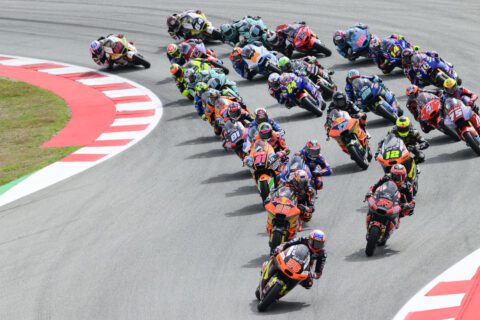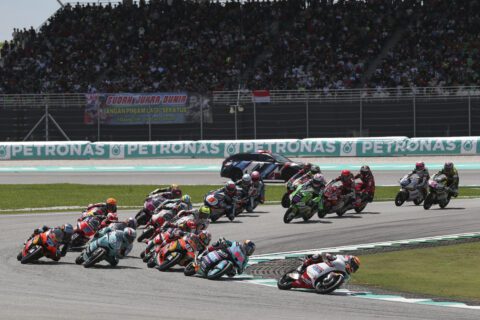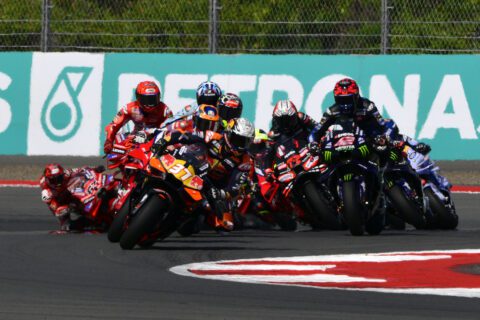It was 1980 when Kawasaki launched the Z1000H1 on to the world and it became the world’s first mass production motorcycle with fuel injection. It was a game changer.
A trend setter for the future and although it took nearly 20 years it was a bike that proved a theory and that was fuel injection works...
Back in the day there was a lot of discussion about fuel injection and whether it was just a gimmick and that it would never work as effectively as carbs. Injection provoked discussion in R&D units as well as in the Red Lion.
The bike itself was iconic and the first to prove a completely new way to work with electronics – trend has continued to develop year after year to the complex MotoGP bikes we have on track now.
Power mode maps, traction control, wheelie control, variable trumpet lengths, the list is endless but one technology that has been creeping up under the radar has been the use of electronics in the area of suspension.
The first production use of semi-active controlled electronic suspension was way back in 1987 on the Mitsubishi Gallant and subsequently has become more and more predominant in the car industry.
Since the late 80s, Öhlins has been developing electronic suspension with its Continuously Controlled Electronic Suspension system (CCES) for automotive racing but it also at the same time had been looking at ways to move the technology on to two wheels.
The Swedish firm first started applying its electronic theories to suspension at the race track way back in the early nineties with Wayne Rainey in the 500 class but the system was soon banned due to the cost involved and advantages gained. On the production motorcycle front, 2005 was the year that BMW became the first manufacturer to offer BMW ESA electronic suspension for sale. It was a simple system that basically just changed the hydraulic settings automatically between comfort, normal and sport modes all by hitting a button on the dash.
It seems that the idea that we will be using computers to make adjustments to our suspension instead of spanners isn’t as farfetched as we might have imagined so let’s have a look at the different methods that we have already on the market or we will be seeing in the future.
There are three main types of technologies available from not so complicated to extremely hi-tech but to explain the different systems first you need to understand how a shock absorber or modern day fork works.
To simplify things let’s take a modern rear shock absorber. Inside this shock you will find a shaft that connects to the linkage system or rear swing arm of the bike and on the other end there is a piston with holes fitted. This piston is on the inside of the main body of the shock and it has oil on both sides.
If you push the shaft up and down, you would find that there would be no damping in extension or retraction. To get the damping forces that give us compression and rebound we need to add little bendy washers called shims to each side of the shaft.
These shims come in hundreds of different diameters and thicknesses and with the experience that the suspension manufacturers have they know how many shims and what size they need to create a given damping or rebound rate for the job a particular motorcycle was designed for...
A good shock absorber also has a range of external adjustment to suit the riders needs for different riding conditions .A good example of this is cruising in town needs a soft damping system to help absorption of bumps and create comfort but scratching through the hills on the same bike needs to have the compression and rebound tightened up to control the extra forces associated with hard acceleration, breaking and cornering. The bike with stiffer suspension is certainly less comfortable but can handle the extra stresses much better.
That’s the basics. But here comes the science:
The simplest technology where it all started. The early BMW ESA systems of the mid-2000s took the need out of pulling over on the side of the road at the city limit to change the damping settings with a screwdriver to sport mode from comfort. All you needed to do was hit a button on the dash which made some small servo motors automatically turn the normal piston shimmed suspension adjusters to a predetermined sport mode.
It wasn’t a system that changed settings as you rode it was just the three settings available for different conditions. BMW’s ESA II was the next offering from the Bavarian factory giving choice of three different suspension damping modes; comfort, normal and sport, and three different preload selections; single rider, single rider with luggage and two-up with luggage. Selecting these pre-programmed settings changed compression and rebound damping as well as spring preload for front and
rear shocks.
Öhlins,who had been working with electronic suspension since the 80s, weren’t sleeping and had formed a partnership with Ducati to make Ducati’s Electronic Suspension (DES) which was first fitted to the 1200 Multistrada and in recent times the incredible Panigale 1199. This (DES) system works similar to that of BMW except for the fact that some fully-automatic functions started to appear.
The Multistrada in comfort mode monitors engine rpm, speed and throttle aggressiveness and calculates when to change the mode to one more suitable. It changes from comfort to normal at 80kph and to sport at a 120kph. The reasoning behind this is to make it simpler to use for the average rider and less cumbersome to have to worry about changing modes as the black box does the thinking for you.
The above systems are on the market for sale now and available on more models every year but what’s around the, erm, corner? The future will bring about some interesting changes to our conception of how the actual internals of the suspension work altogether. Just like those dreaded carburetors that have disappeared off the market shims and standard pistons will be the next
thing to go.
The second technology is a radical departure from suspension as we know it. There are no shims and no piston inside the shock as an electronic valve takes their place. The electronic valve system is probably the most likely to make it in to motorcycle production due to the fact that it has been around in the car industry for a good many years now.
This electronic valve is fitted on the end of the shaft where the piston and shims would normally be in a standard shock. The valve is then electronically-controlled by an external electronic unit which has data such as rpm wheel speed and G forces fed in to it. From this information the ECU then calculates how much current to feed the valve.
The more current the valve has the less damping you have and less current means harder suspension. These types of units are only as good as the electronic control units that they are using and speed is of the essence. Öhlins have an ECU currently which is able to make 400 to 500 changes a second which is where the advantage of a system like this comes in to play. This system can change your suspension continuously as it reads the conditions.
Probably the most intriguing method of new damping technology is the magnetorheological damper. This technology is the most futuristic when it comes to a motorcycle. The principal of the magnetorheological damper system is similar to the standard shock we described at the start in that it has a piston on the end of a shaft inside an outer that is filled with oil.
The shock body also incorporates a coil of wire over the length of the body through which an electric current passes. The damping is not controlled by shims as we described earlier but by the special damping fluid called magnetorheological fluid. This fluid has a special name because what it does is very special. This oil is impregnated with small metal particles that line themselves up like they would if they were stuck on the bottom of a magnet when a current is added.
The current in turn makes the fluid heavier. By changing the current you can change the damping characteristics infinitely depending on the current strength. It sounds farfetched but if you drive a Ferrari or high-end Audi you are riding on this magical fluid.
Whether you hate it or love it electronic technologies are creeping into our lives more and more every year and the same can be said with motorcycles. The subject of electronics and suspension seem pretty farfetched at the moment but the days of using a computer to change your suspension settings isn’t too far off.








![Shane Byrne, Monstermob Ducati, 2003 WorldSBK, action [Gold & Goose]](https://bikesportnews.com/wp-content/uploads/2025/07/Shane-Byrne-Monstermob-Ducati-2003-WorldSBK-action-Gold-Goose-480x272.jpg)

